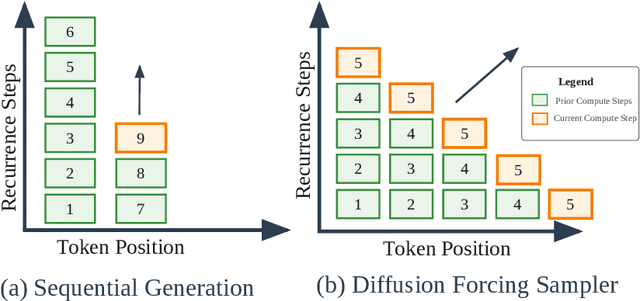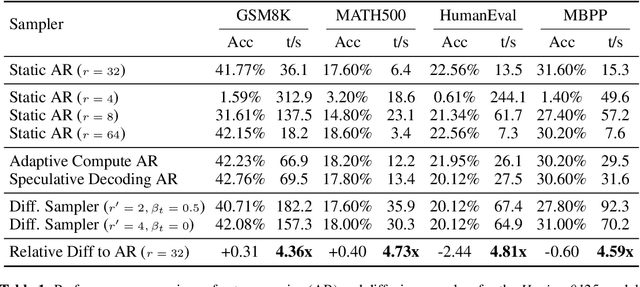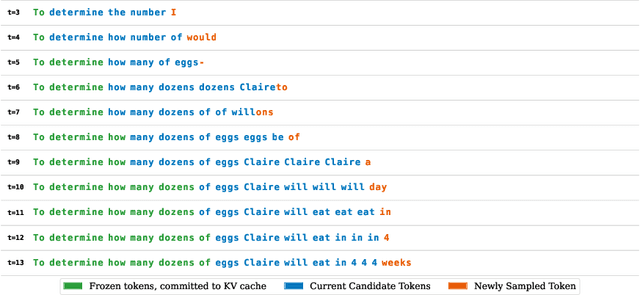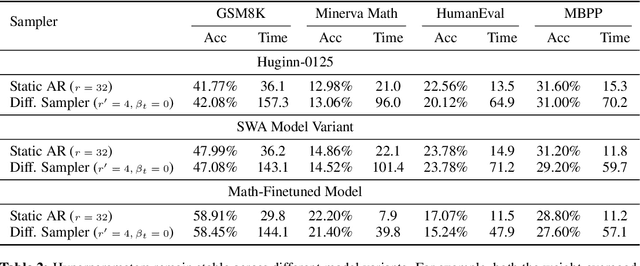Xinyu Yang
Tracking and Understanding Object Transformations
Nov 06, 2025Abstract:Real-world objects frequently undergo state transformations. From an apple being cut into pieces to a butterfly emerging from its cocoon, tracking through these changes is important for understanding real-world objects and dynamics. However, existing methods often lose track of the target object after transformation, due to significant changes in object appearance. To address this limitation, we introduce the task of Track Any State: tracking objects through transformations while detecting and describing state changes, accompanied by a new benchmark dataset, VOST-TAS. To tackle this problem, we present TubeletGraph, a zero-shot system that recovers missing objects after transformation and maps out how object states are evolving over time. TubeletGraph first identifies potentially overlooked tracks, and determines whether they should be integrated based on semantic and proximity priors. Then, it reasons about the added tracks and generates a state graph describing each observed transformation. TubeletGraph achieves state-of-the-art tracking performance under transformations, while demonstrating deeper understanding of object transformations and promising capabilities in temporal grounding and semantic reasoning for complex object transformations. Code, additional results, and the benchmark dataset are available at https://tubelet-graph.github.io.
Efficient Parallel Samplers for Recurrent-Depth Models and Their Connection to Diffusion Language Models
Oct 16, 2025



Abstract:Language models with recurrent depth, also referred to as universal or looped when considering transformers, are defined by the capacity to increase their computation through the repetition of layers. Recent efforts in pretraining have demonstrated that these architectures can scale to modern language modeling tasks while exhibiting advantages in reasoning tasks. In this work, we examine the relationship between recurrent-depth models and diffusion language models. Building on their similarities, we develop a new diffusion forcing sampler for these models to accelerate generation. The sampler advances by decoding new tokens at every forward pass of the model, while the latent states of these tokens can be further refined in parallel through recurrence. Theoretically, generation with our sampler is strictly more expressive than the baseline autoregressive generation using the same time budget on modern hardware. Moreover, this sampler, based on principles from diffusion literature, can be directly applied to existing 3.5B recurrent-depth transformers without any tuning, leading to up to a 5x speedup. Consequently, our findings not only provide an efficient mechanism for parallelizing the extra computation in recurrent-depth models at inference, but also suggest that such models can be naturally viewed as strong continuous, though causal, diffusion language models.
Spiking Vocos: An Energy-Efficient Neural Vocoder
Sep 16, 2025Abstract:Despite the remarkable progress in the synthesis speed and fidelity of neural vocoders, their high energy consumption remains a critical barrier to practical deployment on computationally restricted edge devices. Spiking Neural Networks (SNNs), widely recognized for their high energy efficiency due to their event-driven nature, offer a promising solution for low-resource scenarios. In this paper, we propose Spiking Vocos, a novel spiking neural vocoder with ultra-low energy consumption, built upon the efficient Vocos framework. To mitigate the inherent information bottleneck in SNNs, we design a Spiking ConvNeXt module to reduce Multiply-Accumulate (MAC) operations and incorporate an amplitude shortcut path to preserve crucial signal dynamics. Furthermore, to bridge the performance gap with its Artificial Neural Network (ANN) counterpart, we introduce a self-architectural distillation strategy to effectively transfer knowledge. A lightweight Temporal Shift Module is also integrated to enhance the model's ability to fuse information across the temporal dimension with negligible computational overhead. Experiments demonstrate that our model achieves performance comparable to its ANN counterpart, with UTMOS and PESQ scores of 3.74 and 3.45 respectively, while consuming only 14.7% of the energy. The source code is available at https://github.com/pymaster17/Spiking-Vocos.
Parallel-R1: Towards Parallel Thinking via Reinforcement Learning
Sep 09, 2025Abstract:Parallel thinking has emerged as a novel approach for enhancing the reasoning capabilities of large language models (LLMs) by exploring multiple reasoning paths concurrently. However, activating such capabilities through training remains challenging, as existing methods predominantly rely on supervised fine-tuning (SFT) over synthetic data, which encourages teacher-forced imitation rather than exploration and generalization. Different from them, we propose \textbf{Parallel-R1}, the first reinforcement learning (RL) framework that enables parallel thinking behaviors for complex real-world reasoning tasks. Our framework employs a progressive curriculum that explicitly addresses the cold-start problem in training parallel thinking with RL. We first use SFT on prompt-generated trajectories from easier tasks to instill the parallel thinking ability, then transition to RL to explore and generalize this skill on harder problems. Experiments on various math benchmarks, including MATH, AMC23, and AIME, show that Parallel-R1 successfully instills parallel thinking, leading to 8.4% accuracy improvements over the sequential thinking model trained directly on challenging tasks with RL. Further analysis reveals a clear shift in the model's thinking behavior: at an early stage, it uses parallel thinking as an exploration strategy, while in a later stage, it uses the same capability for multi-perspective verification. Most significantly, we validate parallel thinking as a \textbf{mid-training exploration scaffold}, where this temporary exploratory phase unlocks a higher performance ceiling after RL, yielding a 42.9% improvement over the baseline on AIME25. Our model, data, and code will be open-source at https://github.com/zhengkid/Parallel-R1.
Exploring Classical Piano Performance Generation with Expressive Music Variational AutoEncoder
Jul 02, 2025Abstract:The creativity of classical music arises not only from composers who craft the musical sheets but also from performers who interpret the static notations with expressive nuances. This paper addresses the challenge of generating classical piano performances from scratch, aiming to emulate the dual roles of composer and pianist in the creative process. We introduce the Expressive Compound Word (ECP) representation, which effectively captures both the metrical structure and expressive nuances of classical performances. Building on this, we propose the Expressive Music Variational AutoEncoder (XMVAE), a model featuring two branches: a Vector Quantized Variational AutoEncoder (VQ-VAE) branch that generates score-related content, representing the Composer, and a vanilla VAE branch that produces expressive details, fulfilling the role of Pianist. These branches are jointly trained with similar Seq2Seq architectures, leveraging a multiscale encoder to capture beat-level contextual information and an orthogonal Transformer decoder for efficient compound tokens decoding. Both objective and subjective evaluations demonstrate that XMVAE generates classical performances with superior musical quality compared to state-of-the-art models. Furthermore, pretraining the Composer branch on extra musical score datasets contribute to a significant performance gain.
Temporal-IRL: Modeling Port Congestion and Berth Scheduling with Inverse Reinforcement Learning
Jun 24, 2025Abstract:Predicting port congestion is crucial for maintaining reliable global supply chains. Accurate forecasts enableimprovedshipment planning, reducedelaysand costs, and optimizeinventoryanddistributionstrategies, thereby ensuring timely deliveries and enhancing supply chain resilience. To achieve accurate predictions, analyzing vessel behavior and their stay times at specific port terminals is essential, focusing particularly on berth scheduling under various conditions. Crucially, the model must capture and learn the underlying priorities and patterns of berth scheduling. Berth scheduling and planning are influenced by a range of factors, including incoming vessel size, waiting times, and the status of vessels within the port terminal. By observing historical Automatic Identification System (AIS) positions of vessels, we reconstruct berth schedules, which are subsequently utilized to determine the reward function via Inverse Reinforcement Learning (IRL). For this purpose, we modeled a specific terminal at the Port of New York/New Jersey and developed Temporal-IRL. This Temporal-IRL model learns berth scheduling to predict vessel sequencing at the terminal and estimate vessel port stay, encompassing both waiting and berthing times, to forecast port congestion. Utilizing data from Maher Terminal spanning January 2015 to September 2023, we trained and tested the model, achieving demonstrably excellent results.
Multiverse: Your Language Models Secretly Decide How to Parallelize and Merge Generation
Jun 11, 2025Abstract:Autoregressive Large Language Models (AR-LLMs) frequently exhibit implicit parallelism in sequential generation. Inspired by this, we introduce Multiverse, a new generative model that enables natively parallel generation. Multiverse internalizes a MapReduce paradigm, generating automatically through three stages: (i) a Map stage for adaptive task decomposition, (ii) a Process stage for parallel subtask execution, and (iii) a Reduce stage for lossless result synthesis. Next, we build a real-world Multiverse reasoning model with co-design of data, algorithm, and system, enabling rapid and seamless transfer from frontier AR-LLMs. Starting from sequential reasoning chains, we create Multiverse 1K by converting them into structured training data using an automated LLM-assisted pipeline, avoiding costly human annotations. Algorithmically, we design Multiverse Attention to separate parallel reasoning steps while keeping compatibility with causal attention for efficient training. Systematically, we implement Multiverse Engine to enable parallel inference. It features a dedicated scheduler that dynamically switches between sequential and parallel generation, triggered directly by the model. After a 3-hour fine-tuning with 1K examples, our Multiverse-32B stands as the only open-sourced non-AR model achieving performance on par with leading AR-LLMs of the same scale, evidenced by AIME24 & 25 scores of 54% and 46%, respectively. Moreover, our budget control experiments show that Multiverse-32B exhibits superior scaling, outperforming AR-LLMs by 1.87% on average using the same context length. Such scaling further leads to practical efficiency gain, achieving up to 2x speedup across varying batch sizes. We have open-sourced the entire Multiverse ecosystem, including data, model weights, engine, supporting tools, as well as complete data curation prompts and detailed training and evaluation recipes.
Flexible Operator Fusion for Fast Sparse Transformer with Diverse Masking on GPU
Jun 06, 2025Abstract:Large language models are popular around the world due to their powerful understanding capabilities. As the core component of LLMs, accelerating Transformer through parallelization has gradually become a hot research topic. Mask layers introduce sparsity into Transformer to reduce calculations. However, previous works rarely focus on the performance optimization of sparse Transformer. Moreover, rule-based mechanisms ignore the fusion opportunities of mixed-type operators and fail to adapt to various sequence lengths. To address the above problems, we propose STOF, a framework that incorporates optimizations for Sparse Transformer via flexible masking and operator fusion on GPU. We firstly unify the storage format and kernel implementation for the multi-head attention. Then, we map fusion schemes to compilation templates and determine the optimal parameter setting through a two-stage search engine. The experimental results show that compared to the state-of-the-art work, STOF achieves maximum speedups of 1.7x in MHA computation and 1.5x in end-to-end inference.
Rethinking Circuit Completeness in Language Models: AND, OR, and ADDER Gates
May 15, 2025Abstract:Circuit discovery has gradually become one of the prominent methods for mechanistic interpretability, and research on circuit completeness has also garnered increasing attention. Methods of circuit discovery that do not guarantee completeness not only result in circuits that are not fixed across different runs but also cause key mechanisms to be omitted. The nature of incompleteness arises from the presence of OR gates within the circuit, which are often only partially detected in standard circuit discovery methods. To this end, we systematically introduce three types of logic gates: AND, OR, and ADDER gates, and decompose the circuit into combinations of these logical gates. Through the concept of these gates, we derive the minimum requirements necessary to achieve faithfulness and completeness. Furthermore, we propose a framework that combines noising-based and denoising-based interventions, which can be easily integrated into existing circuit discovery methods without significantly increasing computational complexity. This framework is capable of fully identifying the logic gates and distinguishing them within the circuit. In addition to the extensive experimental validation of the framework's ability to restore the faithfulness, completeness, and sparsity of circuits, using this framework, we uncover fundamental properties of the three logic gates, such as their proportions and contributions to the output, and explore how they behave among the functionalities of language models.
Seed1.5-VL Technical Report
May 11, 2025Abstract:We present Seed1.5-VL, a vision-language foundation model designed to advance general-purpose multimodal understanding and reasoning. Seed1.5-VL is composed with a 532M-parameter vision encoder and a Mixture-of-Experts (MoE) LLM of 20B active parameters. Despite its relatively compact architecture, it delivers strong performance across a wide spectrum of public VLM benchmarks and internal evaluation suites, achieving the state-of-the-art performance on 38 out of 60 public benchmarks. Moreover, in agent-centric tasks such as GUI control and gameplay, Seed1.5-VL outperforms leading multimodal systems, including OpenAI CUA and Claude 3.7. Beyond visual and video understanding, it also demonstrates strong reasoning abilities, making it particularly effective for multimodal reasoning challenges such as visual puzzles. We believe these capabilities will empower broader applications across diverse tasks. In this report, we mainly provide a comprehensive review of our experiences in building Seed1.5-VL across model design, data construction, and training at various stages, hoping that this report can inspire further research. Seed1.5-VL is now accessible at https://www.volcengine.com/ (Volcano Engine Model ID: doubao-1-5-thinking-vision-pro-250428)
 Add to Chrome
Add to Chrome Add to Firefox
Add to Firefox Add to Edge
Add to Edge